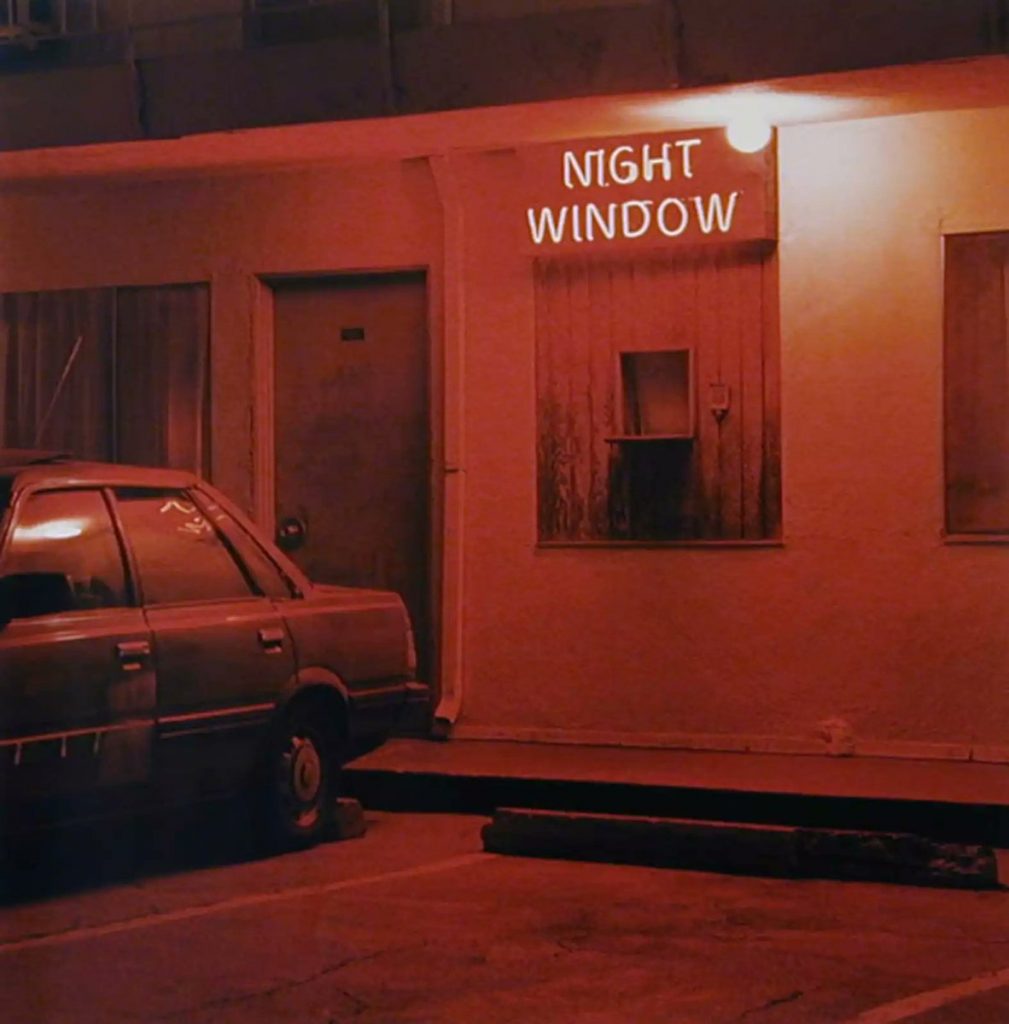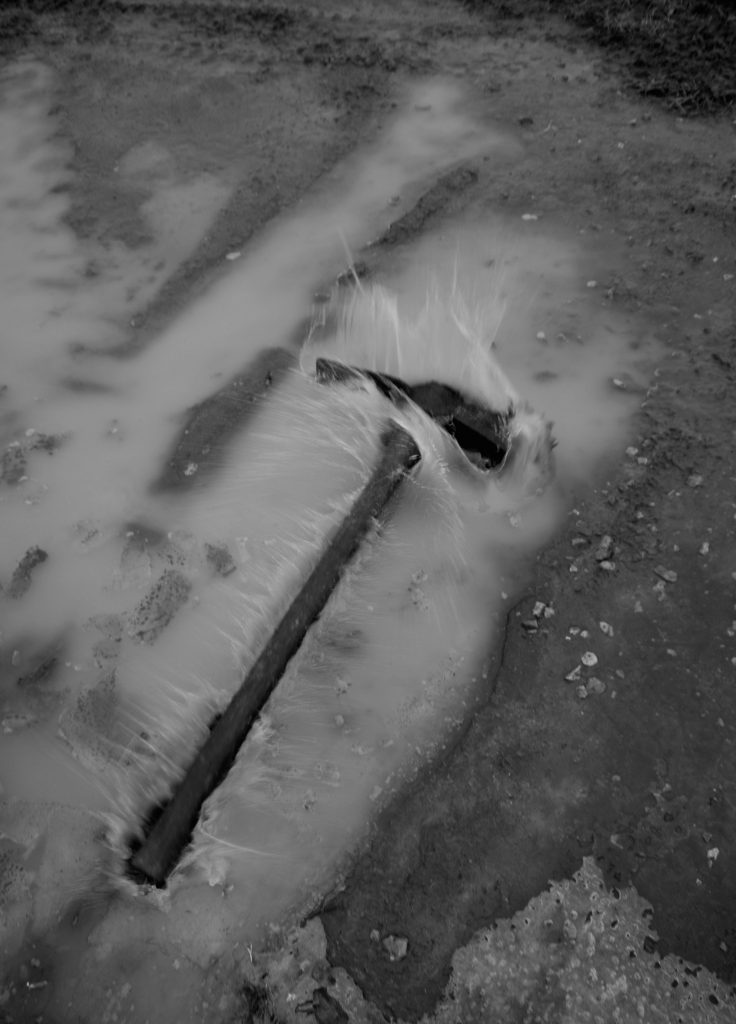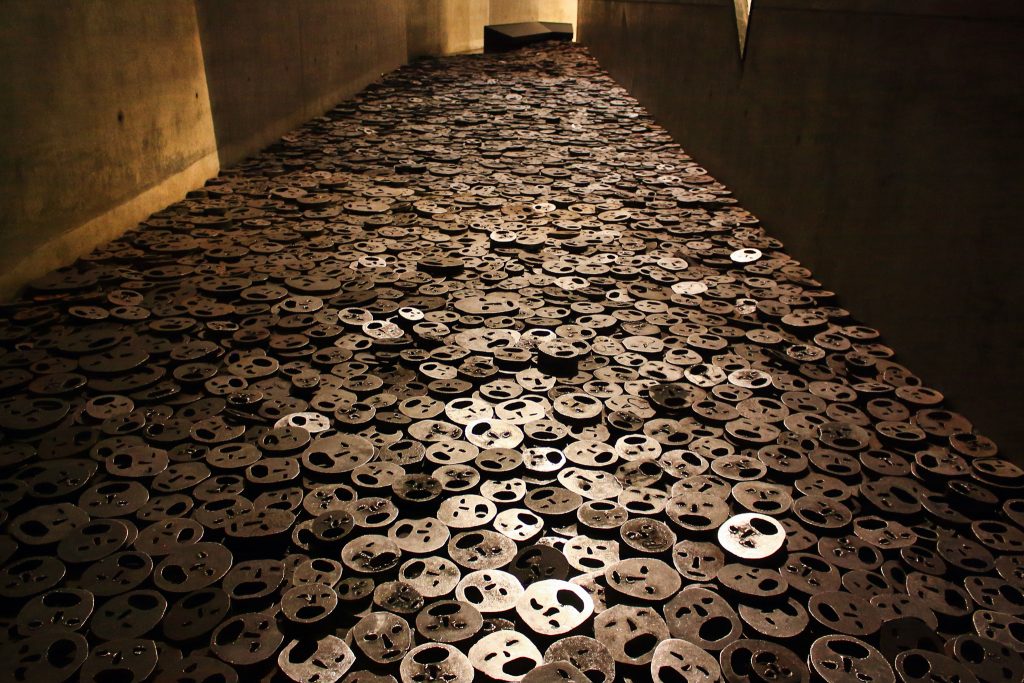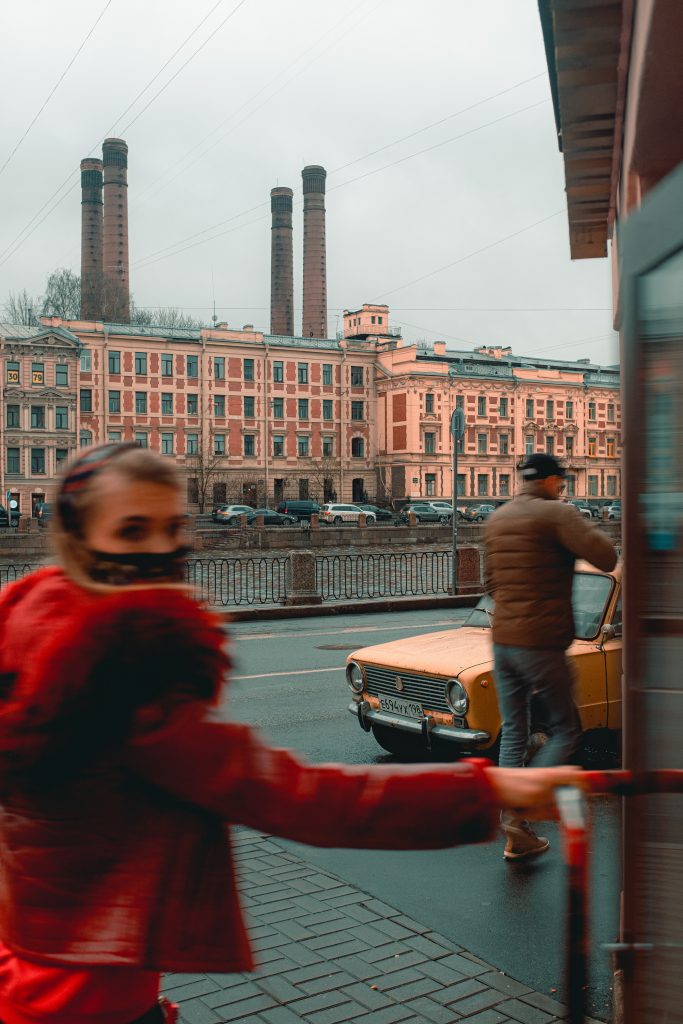In: History

Jeff Brouws | Night Window, Los Angeles, California, 2000
December 29, 2023Jeff Brouws | Night Window, Los Angeles, California, 2000
In the Far West, where Brigham Young ended up and I started from, they tell stories about hoop snakes.
When a hoop snake wants to get somewhere—whether because the hoop snake is after something, or because something is after the hoop snake—it takes its tail (which may or may not have rattles on it) into its mouth, thus forming itself into a hoop, and rolls.
Jehovah enjoined snakes to crawl on their belly in the dust, but Jehovah was an Easterner. Rolling along, bowling along, is a lot quicker and more satisfying than crawling. But, for the hoop snakes with rattles, there is a drawback. They are venomous snakes, and when they bite their own tail they die, in awful agony, of snakebite. All progress has these hitches. I don’t know what the moral is. It may be in the end safest to lie perfectly still without even crawling. Indeed it’s certain that we shall all do so in the end, which has nothing else after it. But then no tracks are left in the dust, no lines drawn; the dark and stormy nights are all one with the sweet bright days, this moment of June—and you might as well never have lived at all.
(Ursula K. Le Guin, from her essay It was a dark and stormy nigh ; or, why are we huddling about the campfire?, 1979)
A number of the images that I share in the main page for this post are also from Brouws’ American West series (1990 – 1993) and the Highway | Approaching Nowhere series. Many of Brouws’ series seem to bleed into each other, or one body of work grows into the next in a manner that does not so much interrupt his ideas as expand them.
I have a certain affinity for abandoned and derelict spaces. I do live in the rust belt wonderland of Niagara, and before that a similar zone in Windsor and Detroit (hence my appreciation of Dave Jordano‘s fine photographs), and my time on the Canadian prairies (with ghost towns in ‘next year’s country’, as captured eerily and evocatively by Danny Singer, for example) fed that interest in an overlapping manner. Brouws’ aesthetic is akin to some past Curator’s Picks I’ve featured : The Great Texas Road Story perhaps being the most immediately similar. But Brouws’ works are less despairing, with the frequency of the neon inviting glow amidst the wastelands, but like many other artists whose work I’ve featured, historical and social themes and concerns are informed by, and informing, his scenes.
“Feelings of isolation colour my photographs – that’s what you’re sensing. It’s fascinating: what’s in your mind, heart and soul gets telegraphed onto the film plane and embedded in the photograph. It can’t be avoided.”
From the Robert Koch Gallery :
“Jeff Brouws photographically explores the American cultural landscape in its myriad of facets. A self-described “visual anthropologist” with a camera, Jeff Brouws utilizes a constructed narrative and typological approach in the making of his work. Over a span of thirty plus years, Brouws has employed a diversity of themes in his work: the American highway, the franchised landscape, deindustrialized inner city zones, as well as riffing on and re-examining bodies of work by luminary artists such as Ed Ruscha, and Bernd and Hilla Becher. Brouws captures the unique cultural experience of Americana and its iconography, visually documenting a vibrant travelogue through the half-experienced, half-remembered landscape of America’s fading culture. Directing his lens toward these temporary obsolete and abandoned sites of American consciousness, he powerfully transforms images of history and dereliction into contemplative and at times humorous commentary on the collective and expressive experience of the American landscape.”
An insightful conversation with the artist can be enjoyed here. When I first encountered Brouws’ work – the primary image in this essay Night Window, Los Angeles, California, 2000 – the quote from Le Guin that opens this meditation on his work came immediately to mind. It’s all about telling stories, some of which are quieter than others, some of which are on the verge of being forgotten and some that we may never have considered. The term ‘into the west’ has connotations both positive and negative, but that is just life, and history, and Brouws’ images encapsulate all these contradictions with an eye for beauty in what might be banal, but definitely resonates with the viewer on multiple levels.
~ Bart Gazzola
Read More
Adrianna Ault & Raymond Meeks | Ohio Farm Auction
December 11, 2023Adrianna Ault & Raymond Meeks | Ohio Farm Auction
The crops we grew last summer weren’t enough to pay the loans
Couldn’t buy the seed to plant this spring and the Farmers’ Bank foreclosed
Called my old friend Schepman up, to auction off the land
He said, “John it’s just my job and I hope you understand”
Hey, calling it your job ol’ hoss, sure don’t make it right
But if you want me to I’ll say a prayer for your soul tonight
(John Mellencamp, Rain on the Scarecrow)
One generation passeth away, and another generation cometh: but the earth abideth for ever. (Ecclesiastes 1:4, KJV)
There’s a memento mori quality to the scenes from the Ohio Farm Auction series. This may be an interpretation informed by several of the other bodies of work by Adrianna Ault (such as her series Levee which led me to the collaborative Ohio Farm Auction series), that are permeated by a sense of mortality and remembrance, as expressed in her writings about those images.
Though these images are not completely empty of people, the more striking and – unsurprisingly – starker moments that stay with you have no figures within them, though their absence and implication is powerful. The line I quote above, in response to this work came to mind immediately upon seeing the Township photos. Mellencamp’s album was a series of laments for a way of life lost (perhaps taken away or relinquished), as the world moves on (this last being closest, I feel, to the artists’ position here, with a gentle consideration of family history and generational change. Township reads more about releasing than resistance..)
The biblical quote came to me in a more indirect manner. Having recently read George Stewart’s post apocalyptic book Earth Abides (from 1949, so it ages poorly, in many ways – or this is perhaps a corolary to the ‘change’ implicit in the story presented in Ohio Farm Auction, of a time to gather and a time to discard), the ideas, again, of what is lost and our – humanity’s – place in the larger narrative of the earth was a further consideration when I engaged with these photographs…
The words of Adrianna Ault, speaking of this collaboration with Meeks (one of a number they’ve done) :
“These photographs were taken one February day in a rural township in Ohio. My partner, Raymond Meeks, and I photographed and watched as all the possessions of my family’s farm was auctioned to the highest bidder. Photographing served as a testimony to the life and work of over one hundred years of farming in my family. This work was published as a collaboration with Tim Carpenter and Brad Zellar in the book Township published by TIS books and later nominated for the 2018 Kassel Fotobookfestival Award.”
That collection of words and photographs has been described as a “careful deliberation on transience and the ultimate meaning of a way of life in the Midwest.”
More of Ault’s work can be seen here and more of Meek’s work can be seen here.
~ Bart Gazzola
Read More
The Great Texas Road Story | Stephen Hood
February 25, 2023The Great Texas Road Story | Stephen Hood
IG: @thegreattexasroadstory
https://www.thegreattexasroadstory.com/
I refuse to remember the dead.
And the dead are bored with the whole thing.
But you — you go ahead,
go on, go on back down
into the graveyard,
lie down where you think their faces are;
talk back to your old bad dreams.
(Anne Sexton, A Curse Against Elegies)
Well, I see your light’s still on, so I guess you must be out there. It’s okay if you don’t want to talk, you know. I don’t want to talk either, sometimes. I just like to stay silent. (Nastassja Kinski | Jane Henderson, from the film Paris, Texas)
The scenes that make up The Great Texas Road Story are cinematic. This is not just the nature of the vignettes captured, but that encountering this work on IG, it is like a continuing tale, with missives ‘sent’ to us, like an ongoing conversation or ‘postcards’ in a continuing narrative….
They have a quality of scouting locations for a film, but I will admit that I’m bringing in my subjective response, again.
Looking at some of these, I’m – obviously, due to the title of the endeavour – reminded of the fine cinematography of the film Paris, Texas, by Robby Müller. But I’m also reminded of the television series Carnivàle, where a travelling carnival trudges across the United States amidst the arid dustiness and despair of the Dust Bowl Depression. Like the moments photographer Stephen Hood presents in The Great Texas Road Story, the episodes in that series are named after the small towns they traverse – and it all starts in Marfa, Texas, in an odd synchronicity to Hood’s travels around Texas for this project. Looking at the site for The Great Texas Road Story, empty places like Spur and Snyder might be Marfa – or vice versa.
And in the end, these places – despite their evocative physical presence captured by Hood – are also characters in a story, repositories for memories and ideas both personal and more public.
“The Great Texas Road Story is an ongoing photography project devoted to the authentic small Texas town. I aim to continue to artistically capture the places in Texas I find compelling and to share that work here.
This photography project began organically in June 2020, when suddenly, I had to get out of town with my girlfriend, as we hadn’t left our tiny Austin apartment in months, and we needed to do something. Had to go. So we booked a campsite at the state park and headed out west to camp in the Davis Mountains near Marfa. A good ole Texas road trip (soothes the soul) was soon underway.
Our first stop was San Angelo, where we saw a porcupine. I brought an old camera and started photographing the landscape of Texas. I hadn’t picked up a camera in months, but from then on, we were on the road every other weekend documenting all of the small towns along the way.
I only moonlight as a Texas documentarian…It is in my spare time that I lovingly chronicle a disappearing Texas.” (Stephen Hood)
That’s an excerpt of Hood’s description of this work, and more of his images can be seen here: but you’ll be able to enjoy more of these moments if you give The Great Texas Road Story a follow on Instagram here.
~ Bart Gazzola
Read More
Julianna D’Intino | Connecting Rods: A Survey of Industry in the Niagara Region, 2015 – 2022
September 22, 2022Julianna D’Intino | Connecting Rods: A Survey of Industry in the Niagara Region, 2015 – 2022
To talk of the legacy of GM when you live in the city of St. Catharines is akin to how your tongue will always go to the gap in your teeth, seeking something that was there and now is not, leaving nothing behind but a perceptible absence you are unable to ignore.
Julianna D’Intino’s images, both moving and still – and I’ve been lucky enough to see several bodies of work she’s produced – often have a local focus, and in some ways she steps into that role of photographer as social historian. Often this involves her adjacent community in Niagara, exploring her own immediate heritage and circle. One such series can be seen here.
Connecting Rods: A Survey of Industry in the Niagara Region is a family story, as well as a local one. The ‘connection’ in the title of this series is not just a nod to an industrial interpretation, but also the families, communities and city that is part of a network that once had its epicenter in the abandoned wastelands D’Intino presents us with….and in her fine words about this series, D’Intino also draws connections to other areas with similar experience, such as with Atlas Steels or John Deere in Welland.
That potential for ‘nostalgia’ doesn’t mean what D’Intino is telling us is through rose – coloured glasses, nor does it gloss over the reality: her words about this work are as unflinching and honest – and engaging – as her photographs.
“This is but one personal case study in the myriad of lost industry of the Niagara Region. Would the return of the Niagara Region as a manufacturing hub provide a sustainable solution to the region’s economic woes? No, it would not. What is missing in the region is sufficient work at wages high enough to sustain a well-balanced life at the Niagara Region’s new inflated cost of living. The last time that such security was widespread was when manufacturing was a leading industry.”
The legacy of GM in St. Catharines is surely a contested narrative, with ground fertile for those from here – like D’Intino, or myself – to mine. It’s as rife as the industrial damage left behind at the site (an ongoing issue in civic politics here which has led to some grotesque and unsettling bedfellows), and there are differing opinions in play. Anna Szaflarski, for example, offers another perspective on this history here.
D’Intino’s site is here, and more images and D’Intino’s considered words about Connecting Rods can be found here.
~ Bart Gazzola
Read More
Menashe Kadisman | Shalechet (Fallen Leaves), 1997 – 2001
August 19, 2022Menashe Kadishman | Shalechet (Fallen Leaves), 1997 – 2001
Installation, Jewish Museum, Berlin
When we were young, we wanted our art to change the world. But when Hitler bombed Guernica, did Picasso’s painting have any effect? I thought that maybe some things of mine could do good. My sculptures didn’t change the war in Lebanon. Maybe art is not about changing anything. It’s about telling you reality. (Menashe Kadishman)
I will admit that I rely upon the term ‘contested narratives’ a bit too much: but when confronted with Kadishman’s installation, where his own personal history (as the child of two committed Zionists, in the early twentieth century) and larger tropes intersect, contradict and in some ways twist and transform in a manner that is more apropos to a fictional story than our expectations of ‘reality’, I feel I have no recourse.
Kadishman’s installation is “primarily associated with the Shoah (the Holocaust) [but] it holds a universal message against violence and human suffering. Kadishman himself notes that the work can relate to different tragedies such as World War I and Hiroshima. In part, Shalechet derives its meaning from the context of its presentation. For example, it took on a new meaning in 2018, when it was exhibited at the Memorial Hall dedicated to the victims of the Nanjing massacre in China.” (I include a link as this horror is lesser known, in the cacophony of savagery that is human history, like the many – repetitive, interchangeable, eternal – ‘faces’ silently wailing on the floor of Shalechet, growing old and rusting and still unheard….)
Read more of Gazzola’s response to this work here.
Read More
Around the Red | Viktor Balaguar
April 14, 2022Around the Red | Viktor Balaguar
Balaguer’s series Around the Red (which includes the image shared here) is perhaps my favourite of his series (a hard decision, though, as Teriberka or Street Photography for Xiaomi are enchanting, too).
Often, his images of St. Petersburg and Moscow suggest a perpetual winter in Russia, but these are less so of that style. The vibrant reds – which never seem forced and hold your eye without overly dominating the scene – run through these works, which are captured moments of places and people. The title implicates historical factors, of course, as Russia and the world are still negotiating the rise and fall of the USSR, in contemporary Russia and beyond those borders (sometimes acknowledging what happened, sometimes not, as we dance ‘around the red’). There is no point when ‘then’ stops and ‘now’ begins in sites of contested narratives (like St. Petersburg or Moscow, Eastern Europe or even in a larger world history), and Balaguer’s Around the Red sometimes hints – and sometimes hammers – at that, visually.
I should add that I began writing this post prior to the most recent acts of war by Russia, but that simply adds more weight to the geo – political insinuations of Balaguer’s scenes….perhaps, as Aleksandr Solzhenitsyn warned us in his The Gulag Archipelago if you “dwell on the past…you’ll lose an eye. Forget the past and you’ll lose both eyes.” To be honest, I had mixed feelings about sharing this work, considering the current political climate, but will temper that with the recommendation of Timothy Snyder’s book Bloodlands: Europe Between Hitler and Stalin, from 2010…..
From here : French photographer, architect and interior designer Viktor Balaguer fell in love at first sight with the ‘Venice of the North’ where he has settled with his family. “Saint Petersburg is a romantic city where you can go from a narrow street to wide avenues, where you follow the sublime and immense Neva River that is completely frozen for part of the year,” he said, calling it “A city of strong contrasts, with a succession of magical palaces and imperial facades whose entrance gates you must cross and visit the dark backyards of the Soviet era. A city deeply melancholic by nature, immersed in a relaxing rhythm of life and permanently open to contemplation.”
In selecting this image, I had a difficult time, as any of the vignettes in Around the Red by Balaguer are worthy of consideration: you can see more of them here, and many of his other fine images at both his IG: @viktor_balaguer and his site.
~ Bart Gazzola
Read More
Recent Comments